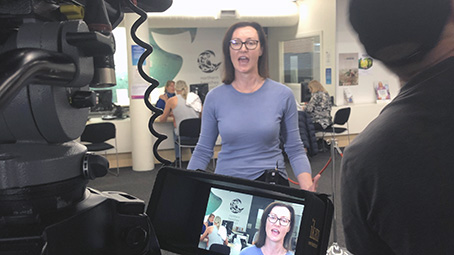Employee communications have moved a long way beyond old-school printed collateral or email. Digital technology, a multi-faceted workforce and – thanks Covid – remote working, have all pushed video to the forefront of employee communications.
Video is a no-brainer for brand marketers: an effective tool for telling stories and engaging buyers.
But it can also be a highly powerful mechanism to build a company culture through internal communication. If your people feel they’re understood and listened to, are a valuable part of your success and proud to be a part of the workforce, then together you will grow and succeed..
So why should your organisation consider using video as part of your corporate communications tool kit?

✔️ It’s effective
Video not only grabs attention but enables you to easily convey emotion to an audience.
Plus by telling inspiring stories about your organisation helps build relationships with your team.
There’s also a feeling of authenticity with video. Showing your processes, your premises and your people is a great equaller.
Video means your message is consistent company-wide, it cultivates a shared sense of purpose, and by being more transparent, makes your organisation more relatable.
67% of employees are better at competing a complex task when communicated by video or test with images than plain text. (Convince and Convert)
✔️ It saves time
Video is a powerful too to communicate information quickly and succinctly across a wide range of pay grades and sites.
Your employees may not have the time – or desire – to read a wordy newsletter or long report. But watching a short video on the go from a leader sharing highlights of team performance, is far easier and quicker to take in.
97% of respondents said that videos help them understand the business. (Renderforest)
✔️ Audiences prefer video
65% of us our visual learners (Mind Tools, 1998), so it’s not surprise that your staff will find watching video easier and therefore more enjoyable than other forms of comms.
It’s not only far easier to absorb the information, but is more likely to be remembered. This saves your organisation time and ultimately money.
48% of all employees consider video the most engaging form of communication (Tech Crunch)
✔️ It’s measurable
From a data perspective, video is a format that enables you to really gauge performance; measuring audience views, length of watch time and amount of replays gives valuable clues on format, topics and execution of your content.
When Black & Decker switched to a video-focused digital training program, it resulted in a 20% increase in employee engagement (Vidyard)
Quite simply, video delivers audiences information easily and effectively, is more engaging, is more likely to drive action and is a data-driven tool that’s helps you measure engagement.
How video can be used in your organisation
✔️ Employee onboarding
Welcome new hires, enhance the onboarding process and kick start engagement early in their company journey with video. Heck go the whole hog and create a suite of videos including walkthroughs of products or locations, introductions from key staff or teams, answers to FAQ and info on common processes.
Video will not only help quickly get newbies up to speed regardless of location but inspire them to contribute to your company’s success and build deeper connection and engagement from the outset.
✔️ Education

Training doesn’t have to be death by powerpoint: instead use the power of video to make educating your teams fun and interactive.
From long form tutorials to quick how-to processes, video can streamline processes and reduce risk. Plus it’s yet another opportunity to connect and share stories of your people to drive further engagement.
Video training is also a highly cost-effective strategy enabling you to efficiently deliver consistent education across your organisation, en masse to different locations.
By moving to video training, It company Cognizant experienced a 189% reduction in training costs.
✔️ Company News and updates
The average office workers receives 121 emails a day. (Campaign Monitor)
Your employees are your biggest brand ambassadors, so regularly communicating key news about your business to them – product update, organisational change, even loosing a big contract – is as much about marketing as it is engagement.
In addition to an announcement – such as Covid – also include answers to the likely common questions staff might ask and discuss additional resources or support on offer for team.
Only 40% of employees know what their organisation’s strategic goals are. (Harvard Business Review)
Using leaders to communicate this helps build relationships and bridges the divide between workers and executives. Sharing the big news with the little guys and acknowledging their contributions, shows you value their input and contribution.
✔️ Go Live
Whether it’s large scale events, lunch and learn presentations or team meetings, keep everyone in the loop by streaming live. It enables you to extend your audience to those who are absent or who work remotely, and from an efficiency perspective works well as you’ll generally only have one take (eg live) and won’t be tempted to re-record multiple times to achieve perfection.
Performances also tend to be be more natural when recorded live.
✔️ Personal video
One to one video builds engagement, increases productivity and saves time.
Forget a lengthy email to a colleague with screen shots and links about troubleshooting an IT problem or a text message reminding someone about a list of tasks or documents to bring to a meeting or event, how about recording a low-fi video instead?
Or boost collaboration amongst remote teams with quick DIY video updates on or summaries of projects or meetings. Reduce time ingesting over composing the perfect email and quickly record video instead.
With an easy system in place, any of your employees can record and send personal videos to colleagues. (Learn more about one to one video HERE)
✔️ Low fi
Video doesn’t have to be professionally produced or necessary look awesome: for personal video (above) or quick turnaround content, DIY will suffice. Save the big bucks for evergreen content such as training and onboarding videos.
Anyone can make a half-way decent video from the comfort of their desk and share with colleagues in a matter of minutes.
Video can save your in-house experts time by quickly and easily sharing product walk-throughs by video conferencing (Zoom, Teams etc) or simple screen capture videos. Presenters need only explain something once and coworkers can choose to watch them in their own time and revise to refresh when needed.
Team members can begin to contribute by becoming video creators and use video in various ways.
Production Tips for internal comms videos
✔️ Make it personal
Apply internal comms best practice principals to your videos. Put your “viewer” front of mind with every video you produce and feature regular employees as well as management where possible.
A new process – explain how it can help them. Profits up – recognise everyones contribution. Company news – get a staff member to present.
✔️ Quality trumps quantity
Keep scripts succinct and punchy and final videos of a quality that means your audience can see and hear your subject. Investing in accessories such as a light and microphone, will see your efforts rewarded with longer views and deeper engagement.
✔️ Creativity

Employee videos don’t have to be dull.
Use visual storytelling techniques, humour and actors to bring your video to life. And in post, motion graphics and animation to up the entertainment-level of your content and catch the eye of your staff.
Make your video, anticipated and must-watch viewing.
✔️ Video-first
Put video at the heart of your employee engagement strategy and embed it as the primary way your organisation share and interacts with its’ people.
Set up systems and processes that make it easy to execute and either outsource or support your people to up-skill.
✔️ Optimise for maximum reach
Borrow from digital marketing tactics to bolster results of your video.
Intriguing subject lines in emails, attention-grabbing thumbnails of videos and vibrant colours and motion text will your video marketing more effective.
Consider incentivising employees for watches to ensure your messages reaches as many eyeballs as possible.
✔️ Centralise
Making videos easy to find and re-visit on demand will mean a far better experience for your staff. And make it easier for you to manage, organise and share.
Choose a platform that helps you centralise all your content including video, and make it mobile-first.
This will make it easy for staff to keep up with the latest announcements and access to educational content such as training courses, office guidelines, tutorials, demos, employee testimonials and so on.
A dedicated platform will also help you drive adoption and improve employee engagement as your employees can react to the videos you’ve or your colleagues have created!
✔️ Video strategy
Create a framework to guide your videos and ensure they align with your business’ culture.
From the types of videos, to branding guidelines, dress code or terminology and language used within, consistency comes with a clearly defined set of rules.
✔️ Make insights matter
Keep track of who is watching and the kind of video that’s popular: a hub makes this easier.
Identifying which videos resonate will deliver better ideation for future videos and ensure your message is reaching its’ intended audience.
Consider other tools to bolster retention and recall, such as quizzes and surveys. Or invite employees to have a say in the content or leave anonymous feedback.
_________
Video minimises barriers to collaboration, delivers information the way employees prefer to consume it and provides a powerful medium for sharing inspiring storytelling.
So if your organisation is looking to empower, educate and engage your people, then consider video as a powerful pathway to cultivating a kick-arse company culture.






